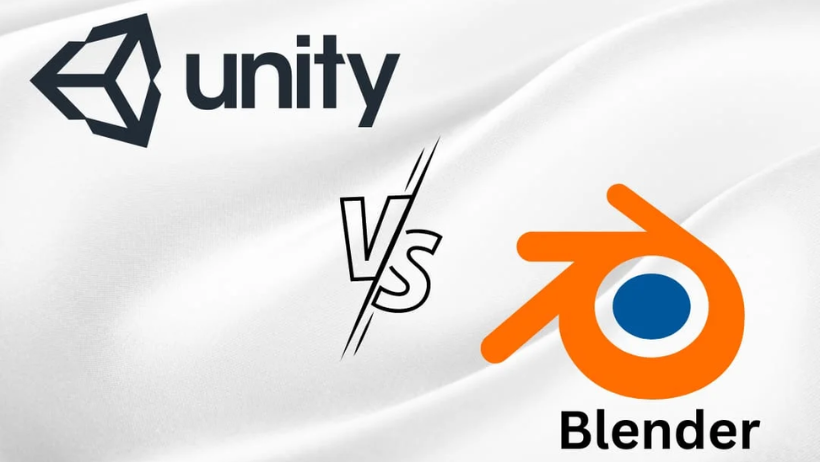If you’re diving into 3D design or game creation, you’ve likely heard of Unity and Blender. These tools are popular, powerful, and widely used in the industry. However, they serve different purposes. So, how do Unity and Blender differ?
This post breaks down their features, strengths, and ideal use cases. By the end, you’ll know which tool to use and when. Let’s get started.

What Is Unity?
Unity is a real-time game engine. Developers use it to build games, simulations, and interactive content. It supports both 2D and 3D projects. In fact, Unity is great for building apps that respond in real-time.
Key features of Unity:
- Game logic and scripting with C#
- Physics and lighting systems
- Asset management
- Multi-platform support (PC, mobile, VR, etc.)
With Unity, you bring 3D models to life. You add movement, interaction, and game mechanics. Therefore, this tool is ideal for game developers.
What Is Blender?
Blender is a 3D creation suite. It lets you model, sculpt, animate, and render 3D content. While Unity builds game worlds, Blender creates the visual assets that fill those worlds.
Key features of Blender:
- 3D modeling and sculpting
- UV mapping and texturing
- Rigging and animation
- Rendering with Cycles or Eevee
Blender is great for artists. It helps you build game characters, props, and environments. Additionally, many people use it to create visual effects and short films.
Unity and Blender: Core Differences
Let’s break down how Unity and Blender differ in key areas:
1. Purpose
- Blender is for creating assets. You build models, textures, and animations.
- Unity is for game development. You build interactivity, game logic, and final apps.
2. Real-Time vs Offline Rendering
- Blender supports both real-time and offline rendering.
- Unity focuses only on real-time rendering for games and apps.
3. Coding
- Unity needs some coding, especially in C#.
- Blender can be used with little to no coding, although Python can enhance workflows.
4. User Base
- Blender attracts artists and animators.
- Unity draws in developers and technical creators.
5. Integration
You can create assets in Blender and use them in Unity. This workflow is very common. As a result, many studios rely on both tools.
Unity and Blender: Which One Should You Use?
This depends on your goal. If you want to make 3D models, then start with Blender. On the other hand, if you want to create a game or interactive app, use Unity. Often, the best approach is to use both tools together.
Let’s look at some use cases:
Use Blender if you want to:
- Sculpt characters or objects
- Animate a short film
- Design detailed textures
Use Unity if you want to:
- Build a video game
- Create an AR/VR app
- Simulate real-world environments
If you’re still unsure, think about this: Blender creates content. Unity makes that content come alive. Therefore, they work best in combination.
Pros and Cons of Unity and Blender
Here’s a quick look at the strengths and limits of each tool.
Blender Pros:
- Free and open-source
- Strong modeling and sculpting tools
- Great for animations
Blender Cons:
- No built-in game engine for logic
- UI may feel complex for beginners
Unity Pros:
- Excellent real-time performance
- Huge support for platforms
- Large community and asset store
Unity Cons:
- Steeper learning curve with scripting
- Asset import from Blender may need tweaks
Blender and Unity Together
You don’t have to choose just one. In fact, many artists and developers use both tools. First, you create a model in Blender. Next, you import it into Unity. Then, you can build interactions and game mechanics.
This combo is very popular in indie game development. Moreover, it’s also useful in education and virtual tours. The tools complement each other well.
Learning Curve and Community
Both Unity and Blender have strong user communities. You’ll find many tutorials, forums, and YouTube channels. However, Unity may be more complex for beginners, especially if you don’t have coding experience. Meanwhile, Blender is easier to start with if you’re only creating assets.
That said, both tools are free to use. Therefore, you can start small and grow your skills over time.
Industry Use of Unity and Blender
Unity is used in games, architecture, film, and even car design. Big studios like Ubisoft and Electronic Arts use it. Blender is used in films, ads, games, and education. For example, Netflix and Pixar teams support Blender’s growth.
This wide adoption means you can learn Unity and Blender and find work in many fields.
Final Thoughts on Unity and Blender
Unity and Blender serve different roles. However, when used together, they’re even more powerful. Unity builds games. Blender creates the assets. Depending on your project, you may need one or both tools.
Instead of choosing between Unity and Blender, why not learn both? They’re free, widely supported, and full of creative potential.
>>> Read more: Best 3D Animation Software to Boost Your Workflow (2025 Edition)
Power Your Renders with 3S Cloud Render Farm
If you use Blender for modeling and animation, you’ll need strong rendering. That’s where 3S Cloud Render Farm comes in. It offers fast, scalable cloud rendering for Blender, Maya, and more.
👉 Explore 3D rendering with 3S Cloud Render Farm
Start building your skills with Unity and Blender today. Whether you’re a hobbyist or a pro, these tools can take your 3D projects to the next level.